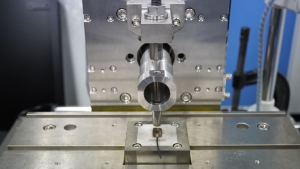Example of bonded workpieces using slit horn tips

Photo 1 Bonding with slit horn tip
The connector ( a component that provide conduction between wires and electronic components), has a metal contact area.
Corrosion/oxidation, poor soldering, and whiskers are among the defects that cause poor conductivity, insulation, and poor contact of connectors. Recently, bonding with gold plating and solderless bonding have undergone testing to in order to reduce the above defects.
When using LINK-US’s ultrasonic bonding technology using complex vibrations to bond stranded wire, since folding back does not occur due to elliptical or circular vibration trajectories, and there is no direction in the bond, vibrational energy is transferred in all directions of the XYZ axes, making it possible to bulk wires together and bond them to the lower plate material.
Bulking wires at the same time as the bond reduces wire inconsistencies that can occur during bonding of stranded wire.
In addition, high-efficiency non-invasive bonding is possible, and since no folding back occurs with vibration, wire breaks can be suppressed, preventing breakage of bonds.
